Posted by Richard Farber on 12-25-2002 01:55 AM:
Three Textiles in the New England Exhibition
Dear All,
without being negative as to the beauty and importance of
this on-line exhibition I believe that three of the four textiles - no.s 23, the
Isfahan wall hanging; 24 the Persian Ikat panel and 25, the yellow Ikat ground
embroidery are NOT closely related to the carpets in the rest of the exhibition.
The Indonesian piece might well be but I don't have enough knowledge of
the textiles of that area.
A quick comparison of the sizes of the
textiles in relation to the sizes of the carpets could have quickly raised the
the question. [see Steve Price on the sizes but 120cm by 80cm could be without
doing the math a possible typical size].
Carpets of a certain size with
similar morphological details probobly are influenced by a long tradition . . .
think also about yastiks . . . and embroideries with similar size and design
probobly are derived from the same tradition.
Can anyone out there think
of the niche form design in 'room size' carpets
say three by our meters or
larger????
In textiles there are other tradition occur in larger sizes
with use a niche or three sided embroidery --- tomb covers, tent panels, and
wedding night ceremonial sheets immeadiately come to mind. These textiles are
often in the two meter by one meter twenty range.
I believe that the
three textiles were not the best choices for this exhibition because they really
are not closely related to the small niche form tradition so well shown in the
knotted examples in the show.
Sincerely
Richard Farber
Posted by R. John Howe on 12-25-2002 07:51 AM:
Hi Richard -
Steve has suggested that we not include the "engsi" in
this discussion, but it offers one instance of a format that often has a niche
and a traditional size of about 4 ft X 5 ft (122 cm X 152 cm) that has tended to
increase in many more recent usages.
I quite often now seen contemporary
"engsi" designs quite faithfully done in room sizes at flea markets. And there
is in one issue of Hali a modern Russian engsi design that was HUGE and analysed
quite seriously with regard to its designs by a Russian rug scholar (Hali was
amused at this latter.)
Regards,
R. John Howe
Posted by Richard Farber on 01-08-2003 06:46 AM:
Dear t'teks,
thought my comments about the New England textiles would
raise some debate.
??????
Richard Farber
as would the
question of size of niche forms, engsis, bolster cover forms etc etc
?????!!!!!
Posted by Steve Price on 01-08-2003 07:16 AM:
Hi Richard,
The post with which you opened this thread probably fell
through the Christmas holiday cracks for many people - I'm glad you gave it a
little bump today.
There are lots of large directional rugs with an
arch-like form at one end, particularly Persian urban workshop products. As a
class, the Qashqa'i "millefleurs" carpets are probably the best known group. As
for small pieces with arch forms, there are plenty of yastiks that meet this
test, and I showed a Kuba khorjin face with an arch in the Salon essay. In fact,
if we accept the notion that a prayer rug can have two mihrabs, one at
each end, there is little reason to eliminate any urban Persian workshop carpet
(or, indeed, almost any textile at all!) from the "prayer rug" group.
My
suggestion that we not devote much time to ensis in this Salon is partly based
on the fact that we did a full Salon specifically on them fairly recently, in
addition to which they seem not to be prayer rugs except in some western minds.
Regards,
Steve Price
Posted by R. John Howe on 01-09-2003 06:55 AM:
Richard et al -
In the post immediatley above Steve says in
part:
"...There are lots of large directional rugs with an arch-like form
at one end, particularly Persian urban workshop products..."
My
thought:
In Salon 50 Wendel Swan showed the spectacular Kerman
"meditation" carpet below that has a niche at one end and is of a somewhat
larger size (perhaps 41/2 feet by 7 feet).
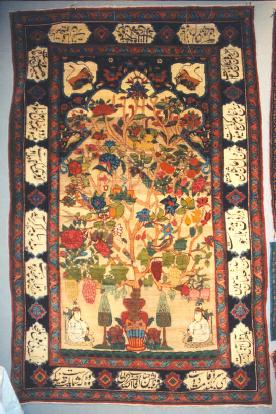
Cecil Edwards describes and gives
examples of seemingly similar Kerman pieces, indicating their designs were
likely taken from Kerman shawls, but does not give dimensions.
And the
Qashqai wove the "millefleurs" design, again with a niche at one end that often
seems larger than the typical range of "prayer" rugs. Here's one from Eiland and
Eiland (1998) page 150, given without measurements.
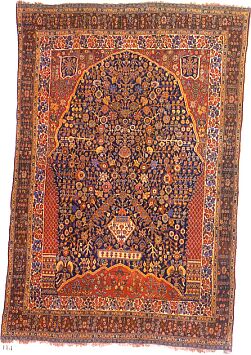
They say this is sourced in
Mughal designs. And in "Flowers Underfoot" (1997) Walker presents a couple of
Mughal examples (Figures 127 and 128) of this type that measure 4 feet X 6 feet
and 5 feet X 7 feet). Earlier in this latter volume (Cat. 19,20 and 21) Walker
presents three pashmina rugs with what he calls flower and "niche" designs. Two
of them are "prayer" size but one (Cat. 21) seems a shade small at 3 feet X 4
feet.
All this to indicate primarily that there do seem to be some one
niche designs that have often been woven in sizes larger than those we usually
associate with the "prayer" format.
Regards,
R. John Howe
Posted by Chuck Wagner on 01-09-2003 01:57 PM:
Arch Support
Greetings all,
Here are a couple examples of Persian city rugs, much
larger than traditional prayer rugs,
with a definite directional mihrab
design. Both date from last quarter 20th century, new rugs,
but are unusual
designs even in todays market.
The first is an Esfahan carpet, with a
solid white field that indicates it was intended for local
consumption (Most
western buyers are put off by the bright whites; thus carpets intended
for
western destinations generally have some tone to the field color or are
washed to mute the whites).
It also shows the move toward use of earthy gray
browns that started in the early '80s. Thankfully,
it was made before the
onset of the use of large areas of dull PINK  .
.
Dimensions are roughly 5x7
feet.
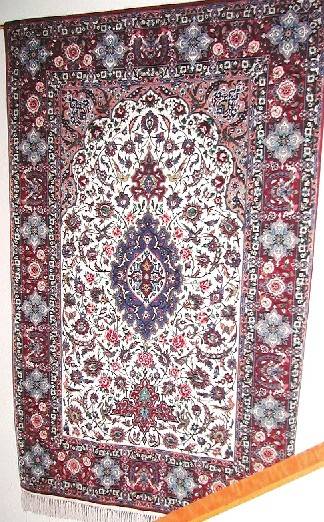
The next
is from the Tabriz region, representing some of the best weaving of the 1970's
at
about 750 knots/in sq. The detail of the dome is not easliy appreciated in
this shot, but unless
someone wants to see more I'll hold off on other
images. The rugs is a post all by itself, for
city rug lovers. Note the lamp
& incense chandelier in the center of mihrab. Dimensions roughly 8x11
feet.
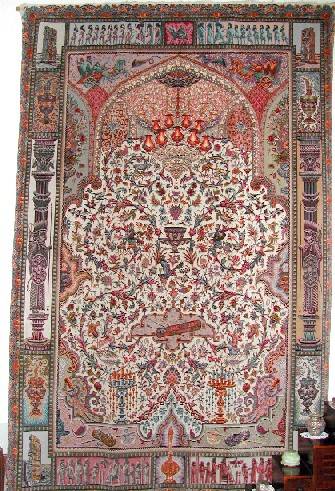
Both
have additional minor design elements highlighting Persian religious symbolism
as well as things
close to the traditional Persian
heart.
Regards,
Chuck
__________________
Chuck
Wagner
Posted by Patrick Weiler on 01-09-2003 10:10 PM:
Half-a-prayer?
Chuck,
The first carpet you show is a perfect example of the
suggestion I made earlier, that a prayer rug is just 1/2 of a
medallion-and-corners rug. When I first opened this page, all I could see was
the top half of the rug. My first impression was that I was going to see a
typical medallion-and-corners rug. Only upon scrolling down did I see that the
bottom of the rug did not continue the symmetrical pattern. I suspect that the
workshop that this rug was woven in also produces a full medallion rug of
virtually the same design.
A prayer rug such as yours, woven from the "top"
would have exactly the same design as the top half of your rug, but the bottom
half would not be a symmetric copy of the top - but instead be squared off as in
your example. It would be easy for a weaver to begin the rug as though weaving a
medallion rug and then finish it as a prayer rug, with the squared-off bottom of
the field.
I like both of those rugs, by the way.
Patrick
Weiler
Posted by Robert Alimi on 01-09-2003 10:32 PM:
Note about the NERS exhibit
This seems like as good a place as any to mention that several of the images
in the NERS exhibit have been "upgraded". We've put new images in place for the
following plates: 7, 8, 9, 23, 24, 25 & 26. Plates 7, 8, 9 & 26 also
include improved detail images. Plate 6 includes 2 new "pop ups" to illustrate a
couple of analogous pieces mentioned in that plate's descriptive text. All the
images are clickable, and will open a much larger version of the same image in a
new window. Thanks to Yon Bard for most of these new images. He is now the
official NERS photographer...whether he likes it or
not!
Regards,
-Bob
Posted by Chuck Wagner on 01-10-2003 11:42 AM:
Hi Patrick,
I understand your point about half-medallion rugs, but I
don't think it's much more than coincidence. It's fairly common to see the
architectural geometry of religious edifices reflected in plan view designs such
as Persian gardens (the real ones) and Persian house plans. That the same
geometry also shows up in carpets is a natural follow-on for me.
For that
reason I probably wouldn't characterize either of the two rugs shown above as
prayer rugs, because I reserve that term for something intended for use beneath
the knees of a pray-er. But, I definitely agree that they have a strong
religious significance and designs based on the interiors of
mosques.
Regardez:
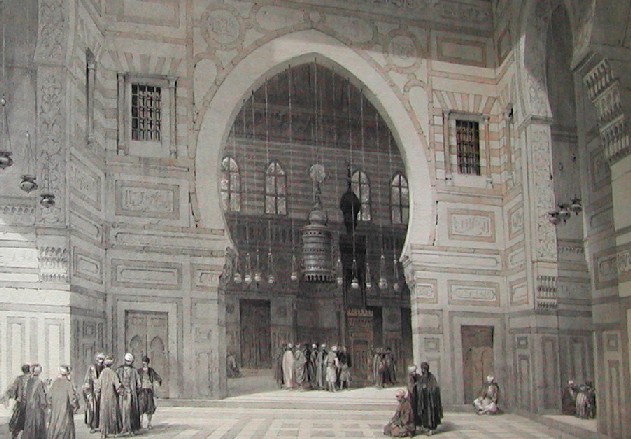
from a Roberts lithograph of the Sultan El Ghoree mosque in
Cairo.
And this 1950s-ish Kizl Ayak rug from Afghanistan illustrates that
such detail can certainly show up in a small rug:
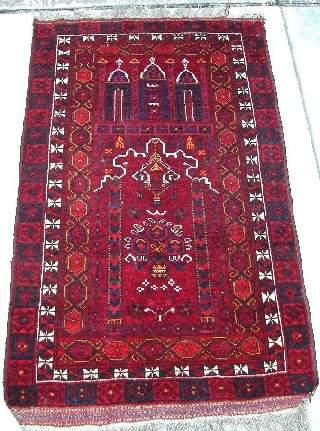
Regards,
Chuck
__________________
Chuck
Wagner


 .
.


